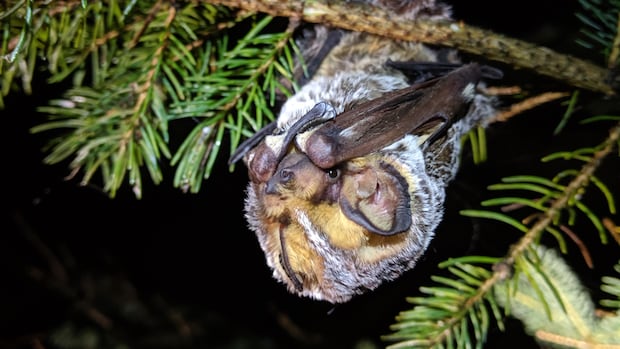Science
Advocates Call for Action as Wind Turbines Threaten Bats in Canada

Wind turbines in Canada are posing a significant threat to migratory bat populations, prompting calls from conservation advocates for urgent action. According to research, these turbines have led to high fatality rates among bats, particularly the hoary bat, eastern red bat, and silver-haired bat, all of which are classified as endangered by Canada’s Committee on the Status of Endangered Wildlife.
Cori Lausen, director of bat conservation with the Wildlife Conservation Society, emphasized the dire situation, stating, “We are not talking about if these migratory bats go extinct. We are just talking about when.” She highlights the pressing need to implement solutions to mitigate further declines in bat populations, such as adjusting turbine operations during key migration periods.
Bats, often misunderstood and associated with folklore, play a critical role in ecosystems. They assist in pest control, which reduces the need for chemical pesticides in agriculture. Research published in the journal Science in 2024 indicates that a decline in bat populations can lead to increased pesticide use, negatively impacting crop health and raising infant mortality rates among livestock.
Understanding the Risks of Wind Turbines
Lausen first became aware of the dangers posed by wind turbines in the early 2000s while studying bats at the University of Calgary. The discovery of dead bats near turbines operated by TransAlta prompted her research into the fatalities. “Seeing the dead bats is really hard because these are long-lived mammals that can’t withstand these high fatality rates,” Lausen recalled.
Most fatalities were attributed to collisions with turbine blades, although some bats succumbed due to pressure changes near the turbines. The reasons for their proximity to these structures remain unclear. Lausen speculated that bats might be drawn to the turbines out of curiosity or may misinterpret them as trees during their mating rituals.
Proposed Solutions to Protect Bat Populations
In light of the ongoing issue, Lausen and her team proposed a strategy known as “curtailment,” which involves temporarily pausing turbine operations. Bats typically fly during low wind conditions, allowing for potential shut-downs that would minimally impact energy production. Research conducted in Alberta in 2022 revealed that seasonal overnight stoppages could prevent a significant number of bat deaths while decreasing profits by less than 2%.
In 2013, Alberta established guidelines for wind energy projects concerning migratory bats, incorporating curtailment measures. The following directives further limited the allowable bat fatalities at wind farms. While some provinces have implemented regulations regarding bat death thresholds, enforcement remains inconsistent, with companies facing no penalties for exceeding these limits.
Despite these efforts, Lausen argues that the existing measures are insufficient given the rapid increase in wind turbine installations since 2007. Current thresholds are calculated per turbine, which can still result in considerable bat fatalities overall. Canada’s wind power capacity has surged, raising concerns about the cumulative impact on bat populations.
Innovative Technologies for Smart Curtailment
Innovative solutions are being explored to enhance curtailment efforts. Kent Russell, a senior wildlife biologist with Western Ecosystems Technology Inc., is working on technologies that could allow turbines to shut down only when bats are detected nearby. This method would involve programming turbines to respond to bat activity, thus minimizing unnecessary power interruptions.
Sarah Palmer, a former director of a wind project with Toronto-based renewable energy company Potentia, stressed the importance of adopting these new technologies. “What industry is looking for with the new technologies is for provinces to accept these new types of technologies as an option instead of blanket curtailment,” she said.
As research continues to uncover crucial aspects of bat migration and population health, Lausen advocates for stricter regulations to prevent the construction of wind farms along migratory routes. “The hope that we can keep these bats from extinction is what keeps me going,” she noted. “Hopefully we can keep these bats alive long enough to advance technologies for renewable energy to the point that maybe we won’t kill bats anymore.”
The ongoing dialogue surrounding wind energy and wildlife conservation highlights the need for a balanced approach that prioritizes both climate solutions and biodiversity.
-

 Science3 months ago
Science3 months agoToyoake City Proposes Daily Two-Hour Smartphone Use Limit
-

 Top Stories3 months ago
Top Stories3 months agoPedestrian Fatally Injured in Esquimalt Collision on August 14
-

 Health3 months ago
Health3 months agoB.C. Review Reveals Urgent Need for Rare-Disease Drug Reforms
-

 Technology3 months ago
Technology3 months agoDark Adventure Game “Bye Sweet Carole” Set for October Release
-

 World3 months ago
World3 months agoJimmy Lai’s Defense Challenges Charges Under National Security Law
-

 Lifestyle3 months ago
Lifestyle3 months agoVictoria’s Pop-Up Shop Shines Light on B.C.’s Wolf Cull
-

 Technology3 months ago
Technology3 months agoKonami Revives Iconic Metal Gear Solid Delta Ahead of Release
-

 Technology3 months ago
Technology3 months agoApple Expands Self-Service Repair Program to Canada
-

 Technology3 months ago
Technology3 months agoSnapmaker U1 Color 3D Printer Redefines Speed and Sustainability
-

 Technology3 months ago
Technology3 months agoAION Folding Knife: Redefining EDC Design with Premium Materials
-

 Business3 months ago
Business3 months agoGordon Murray Automotive Unveils S1 LM and Le Mans GTR at Monterey
-

 Technology3 months ago
Technology3 months agoSolve Today’s Wordle Challenge: Hints and Answer for August 19









